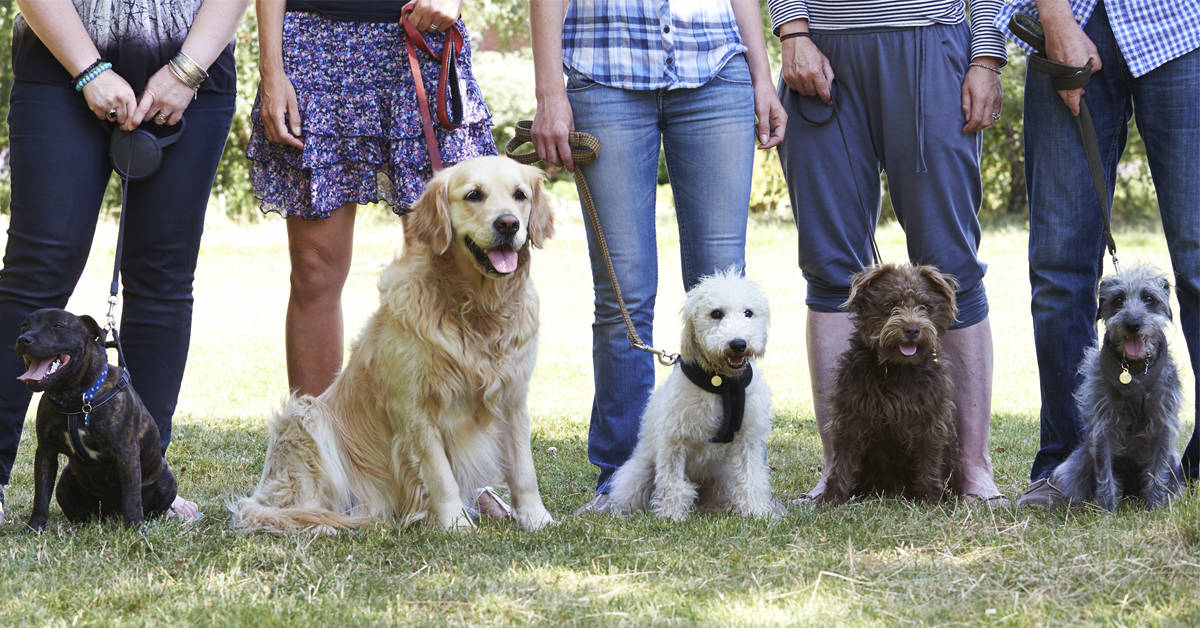“This post contains affiliate links, and I will be compensated if you make a purchase after clicking on my links.”
Whether you’re teaching basic obedience, fun tricks, or sports and agility, the methods you use will be based on one of three main approaches to dog training.

Ask a dozen different dog trainers how to train your dog, and you’ll likely get a dozen different answers. While there are hundreds of different dog training techniques, methods, tools, and modalities, nearly all techniques are based on three different approaches: dominance theory, a scientific approach, or positive reinforcement.
Despite years of research and study of canine development and behavior, trainers around the world have been unable to agree on a single method. So, in order to choose which technique you prefer to use in training your own furriest family members, it’s important to understand tools and procedures used in each one.

Dominance Theory
The dominance theory, sometimes referred to as “traditional dog training” because its methods pre-date modern science-based methods, is based on wolf-pack behavior and that belief that dogs behave in ways that would prove their “rank” or dominance over another member of their “pack.” A dog’s pack would include other dogs in the household as well as the human members of their family.
In this type of training, the dog owner corrects bad behavior through a variety of aversive or punishment methods, like choke chains and prong collars, leash snapping, pinching, “alpha-rolling,” and electronic collars (also known as shock collars) the moment bad behavior is performed with the goal of eliminating the behavior while showing their dog they are the “alpha” and should be obeyed.
Once the most widely used training method, dominance training is quickly becoming less popular as research into dog behavior and cognition has proven that dogs and wolves are actually quite different, especially in terms of pack behavior and how they learn and solve challenges they face. In fact, this method is considered borderline abusive because punishment in the form of pain and intimidation is frequently used.
A recent study showed that punishment and aversive training can have long-term negative effects on your dog’s mental state. Still, despite losing popularity, dominance training remains one of the three most commonly used methods of dog training with famous dog trainers including Cesar Millan and William Koehler continuing to promote and teach the techniques.

Positive Reinforcement
Positive reinforcement training is essentially the opposite end of the training spectrum from dominance theory training. This method was developed based on Carl Rogers’ ideals of “unconditional positive regard.” In other words, while you may not always like your dog’s behavior, you will always love and care for the dog himself. Its approach is based on providing your dog with guidance through unconditional love.
In positive training, bad behavior is ignored and good behavior is rewarded. Because dogs generally repeat behaviors that are rewarding to them and discontinue behaviors that are not, positive training works by teaching the dog which behaviors earn a reward; usually a treat, toy, praise, or affection.
A common argument against a strictly positive approach, however, is that while good behaviors are easily learned (for example, a dog that’s been positively trained will quickly learn that when he wants a treat, he should sit down, whether he’s given the ‘sit’ cue or not), it is not communicated to the dog when a behavior is bad or inappropriate. For example, because bad behavior is ignored and good behavior is rewarded, a dog that isn’t taught that behaviors, like chasing squirrels or counter-surfing, are bad will often continue those behaviors because they are self-rewarding; chasing squirrels is fun and counter-surfing often results in a tasty snack.
Instead of communicating when a behavior is wrong or inappropriate, positive trainers recommend taking steps to prevent a dog from engaging in bad behaviors, like putting up baby gates to prevent access to the kitchen, or distracting the dog with training exercises and treats when a squirrel passes by so that the dog won’t notice and take chase.
Positive reinforcement training is favored among owners of fearful and reactive dogs, dogs that lack in confidence, and dogs that were previously abused as traditional training methods have been shown to increase fear and aggression in these dogs.
Positive reinforcement-based training has been popularized in recent years by celebrity dog trainers including Victoria Stilwell and Kyra Sundance. But, while these trainers focus primarily on positive reinforcement techniques to help people and their dogs live together in harmony, they continue to closely follow scientific research and use those findings to develop more effective ways of communicating with dogs.

The Scientific Approach
Science-based dog training is very similar to positive reinforcement training in that coercion, force, and physical punishment are never used to train good behavior. Unlike dominance theory training where a dog obeys out of fear of being punished, or positive reinforcement training where a dog obeys in order to be rewarded, science-based training relies heavily on research by veterinarians and animal behaviorists with an understanding of dog behavior and cognition.
Modern science, for example, has proven that dogs are sentient beings, capable of thought and with an ability to reason and problem-solve. While a dog’s range of emotion is not as broad as a human’s, it has been proven that dogs are capable of feeling love, fear, happiness, and depression, among others. Scientific research has also proven that, in addition to the basic necessities to sustain life – food, water, shelter, and air, dogs have psychological needs and are capable of communicating those needs to humans that understand them.
In a scientific approach to dog training, rewards are given for appropriate or desired behaviors, but, unlike the strictly positive reinforcement method where bad behavior is ignored, if an inappropriate or undesired behavior is performed, rewards are taken away. In oversimplified terms, science-based trainers teach through effectively communicating with the dog in ways they comprehend. A variety of methods are used, including positive reinforcement, shaping, teaching by example, and negative reinforcement, among others.
For example, if you were training a dog to walk nicely on a leash, without pulling or dragging you down the street using the dominance theory method, you would use a choke or prong collar and give a quick leash jerk every time the dog pulled their leash. Over time, the dog would stop pulling simply to avoid the punishment. Alternatively, to leash train a dog using only positive reinforcement training, you would ignore the dog pulling on the leash and, instead, reward with treats or praise each time he walks nicely, without pulling. Over time, the dog would stop pulling in anticipation of being rewarded. While both methods essentially work to end leash pulling, neither method truly communicates to the dog what the desired behavior is. The dominance-trained dog is obedient for fear of being punished, while the positive-trained dog is obedient for the possibility of reward – as long as that anticipated reward is more exciting than whatever he may encounter at the end of the leash.
On the other hand, to train a dog to walk nicely on a leash using science-based training, you would either use a no-pull harness that applies slight pressure or redirects the dog away from their intended target when they pull, or you would stop and hold the leash when the dog pulls, indicating to them that as long as they pull, they will not reach what they’re pulling toward. Only when the dog stops pulling will he be allowed to move forward. This way you are both rewarding good behavior (not pulling) and communicating when behavior is bad.
Some of the most important advancements in science-based training have been explained by behaviorists Sophia Yin and Alexandra Horowitz who both use an extensive understanding of canine behavior and cognition to teach pet parents how to effectively communicate with – and therefore train – their dogs.
Ultimately, it’s your right (and responsibility) as a dog owner to choose which training method is best for your dog and your lifestyle.
Found this article helpful? Pin it!




















Rudy
Dec 17, 2021 at 5:23 pm
This is a bad article that demonstrates a deep misunderstanding of positive reinforcement training. I’m embarrassed that someone felt bold enough to explain their opinions on different training methods as if those are the facts.
There is no distinction between positive-reinforcement dog training and science based dog training. They are the same. Positive reinforcement uses force-free techniques to teach dogs which behaviors are undesirable. That’s the whole point!
This kind of misinformation is why it took me too long to fully accept positive reinforcement as an entire training method. This article is irresponsible to your readers and to dog lovers who seek to do right by their best friends.
Pingback: 7 Best Dog Training Techniques | Dog Vet Tips
Pingback: Abandoning Breed Stereotypes On Canine Aggression - imassenger.com
Pingback: Abandoning Breed Stereotypes On Canine Aggression – Dog Training
ali
Nov 4, 2018 at 10:14 am
Nice blog.good way to explain how to train your dog. thank you so much. I want to train my puppy to walk nicely on a leash
hanan ejaz
Nov 4, 2018 at 10:10 am
Nice informative blog about dog training thanks really helpful!